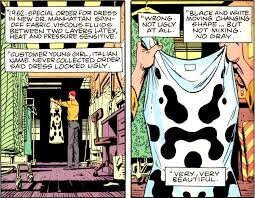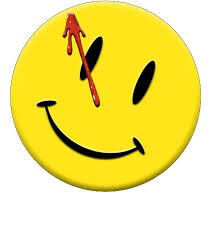Watchmen, Episode 1, Part 2: Welcome to the Bizarro World
When Walter Kovacs, the future masked vigilante known as Rorschach, first sees the experimental fabric from which he would make his bizarre mask, he is immediately drawn to it as both an aesthetic and philosophical statement:
“1962. Special order for dress in new Dr. Manhattan spin-off fabric. Viscous fluids between two layers latex, heat and pressure sensitive.
“Customer young girl, Italian name. Never collected order. Said dress looked ugly.
“Wrong. Not ugly at all.
“Black and white. Moving. Changing shape…but not mixing. No gray.
“Very, very beautiful.”
When Kovacs speaks of black and white here, he is not talking about race. Rather, he is reaffirming his unshakable faith in a binary notion of good and evil. This is the code he will live and die by: black and white, no gray. The limits of this approach are immediately obvious, particularly when he refutes his customer’s assertion that the dress is ugly: “Wrong. Not ugly at all.” How many people would respond to a characterization of something as beautiful or ugly by saying “wrong?” There is so little room for subjectivity in Rorschach’s world that he even avoids using the word “I.”
Rorschach, who is modeled on Ayn-Rand -inspired Steve Ditko heroes (The Question, Mr. A), has undeniable fascist leanings, but race does not seem to be one of his concerns. One of the many ironies of liberal attempts at being post-racial is the emphasis on being “color-blind” (“I don’t see color”). Rorschach, the emotionally stunted dualist, comes close to making color-blindness literal, since he has no use for shadings at all. Someone who is color blind only sees black and white. How useful is that as a metaphor for being post-racist in a country where the most urgent racial divides are precisely about black and white? [1]
Black Like Curly
After the initial scene featuring the Tulsa Race Massacre, the first episode of Watchmen seems determined to reverse the racial polarity it has just spent ten minutes documenting in bloody detail. The next scene shows a white driver stopped by a Black cop, with the Black man gunned down by the white suspect. From there we go to an all-Black performance of Oklahoma (perhaps the whitest of musicals, which is saying something). In the final scene, white Tulsa Police Chief is hanging from a tree, possibly lynched by an elderly black man in a wheelchair holding the same note as the boy who survived the massacre. [2] And all of this is set in a context where poor white people in the “Nixonville” trailer park are outraged over President Robert Redford’s policy of reparations (“Redfordations”).
If this show is puzzling as a sequel to Alan Moore’s and Dave Gibbon’s Watchmen, it’s all the more confounding as a television series made after Ferguson. In the various interviews to come out over the past week, Lindelof has made it clear that he is aware of the potential pitfalls for a white man to take on this material, and has also reminded readers that his writers’ room includes people of color. So I want to give him the benefit of the doubt, at least for now, and see where this all leads.
The racial make-up of Watchmen’s Tulsa is complicated. The police force is determined to fight white supremacy, a phenomenon that is clearly alive and well, and even intensified by resentments over the “Redfordations.” But, in a reversal of the situation in the graphic novel, the police now wear masks (as do their Rorschach-inspired enemies). So even the police, who seem to be the…good guys?…here, have a whiff of fascism about them. Looking Glass’s reflective mask takes Rorschach’s faceless face one step further: the only thing you can see in his face is your own. Angela Abar, the retired cop who fights crime as Sister Night, covers most of her face in cloth, but applies black coloring to her already black forehead as part of her disguise.
“SO MANY FACES…SO FEW SMILES..”—THE JOKER IN BATMAN: THE DARK KNIGHT RETURNS
Angela’s civilian identity is as mysterious as her costumed alter ego. The man the kids call “Daddy” is listed in the credits as Cal Abar, but Angela’s father was Marcus Abar, suggesting either that Cal took her name (an unusual step, though not unheard of), or that something even more complicated is going on. And, not to put too fine a point on it, there is probably a reason that her two children are played by actors whose skin is far lighter than either hers or Cal’s. The original Watchmen made a great deal out of the mysteries of paternity; is Lindelof following suit?
In Moore’s and Gibbons’ tale, the murder victim was also one of the characters' unacknowledged father. Let me go out on a limb here: the police chief found dead in the final moment is a call back to the murder that set the original Watchmen in motion, from a death involving an elevated height to the focus on a button stained by blood (the smiley face in the comic and the chief’s badge in the film). Is the police chief someone’s secret father? Maybe that of Angela’s children?
Other Minor Mysteries
When Looking Glass is interrogating his suspect, he asks if the man believes that transdimensional attacks are hoaxes stage by the US government, as an image of a giant squid fills the screen behind him. Both the attack and the squid should be no surprises to readers of the comic, but the use of the plural should give us pause. How many attacks have their been? Does this refer to the rain of mini-squids we see halfway through the episode?
How did the police end up using a flying machine that looks like Dan Dreiberg’s Owlship?
What on earth is going on with Adrian Veidt and his naked thigh massages?
Is the man in the wheelchair Hooded Justice?
Fearful Symmetry
Lindelof has wisely chosen not to imitate the writing style or visual composition of the graphic novel, thereby freeing himself from an influence that could only be an obstacle. He’s also not trying to contort the medium of television in order to copy the formal narrative innovations that Moore and Gibbons brought to their work (the multiple voiceover narrations and the Tales of the Black Freighter comic). But he does end the episode with a visual echo of the first issue of the comic (the corpse and the badge). Given Lindelof’s previous history of experimental televised narrative, I would not be at all surprised to discover that the way this episode was assembled will end up resonating profoundly with the eight episodes to come.
R.IP Chief Judd Crawford
I admit that I had assumed that Don Johns was in the show for the long haul. Don, you are now the Sean Bean of Watchmen. Of course, this being Watchmen and a Damon Lindelof production, there’s always flashbacks. So I don’t know yet if we should be saying “Valar morghulis” or “Nothing ever ends."
Note
[1] The fact that the customer has an Italian name works rather well here, since Italians took several generations to become “white” in Americans eyes. This is most likely unintentional, since the important point for the book is not that the woman has an Italian name per se, but that that name turns out to be Kitty Genovese.
[2] At this point, it’s unclear what this character’s connection to the crime actually is. But the first time he sees Angela, he asks her if she thinks he could lift 200 pounds. So maybe he did.
Comments (2)
Austin Johnson 9 months ago · 0 Likes
My money is on Don Johnson being the one responsible for the Cavalry's resurgence. He's the sherriff from the film-within-a-film that opens the episode.
Eliot Borenstein 9 months ago · 0 Likes
Huh--I hadn't though of that!



